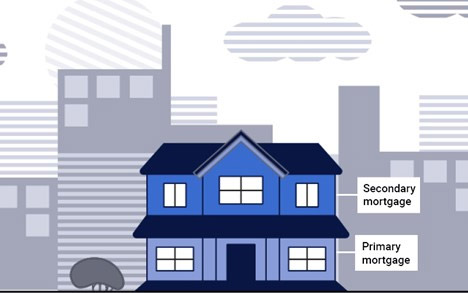Homeowners
HELOC vs. Second Mortgage: Which is Better?
December 28, 2023
Are you looking to tap into the equity of your home but unsure whether a HELOC or a second mortgage is the better choice? You're not alone in this dilemma. While both options allow you to borrow against the value of your home, understanding the nuances between them is crucial to making an informed decision. In this comprehensive guide, we'll delve into the advantages and considerations of each to empower you to choose the financing solution that aligns with your needs and goals.
What is a second mortgage?
A second mortgage is a second loan that you can take out on your home in addition to your primary mortgage. It allows you to borrow against the equity you have built up in your property.
The funds from a second mortgage can be used for various purposes, such as home improvements, debt consolidation, or other financial needs. Unlike your primary mortgage, which is typically used to purchase the home, a second mortgage is a separate loan with its own terms and interest rate.
It's important to carefully consider the terms and repayment obligations of a second mortgage, as it will be an additional financial commitment. However, it can provide you with access to funds that can help you achieve your goals while leveraging the value of your home.
The pros and cons of a second mortgage
Second mortgages can be a helpful way to access cash, but they may also put your home at risk if you are unable to make the payments. It is important to weigh the pros and cons carefully before you decide if a second mortgage is right for you. Some of the most notable include:
Pros:
- Extra Cash: A second mortgage can provide you with a lump sum of cash that you can use for whatever you want—be it debt consolidation, home improvements, or even a much-needed vacation.
- Leave Your First Mortgage Alone: If you are happy with the interest rate on your first mortgage there’s no need to touch it. It isn’t necessary to refinance with a second mortgage since it's a completely new loan.
- Lower Interest Rates: Second mortgages often come with lower interest rates compared to credit cards. This can make them a more cost-effective way to borrow cash to pay off debt.
Tip: Look for a Fixed-Rate Second Mortgage so your interest rate remains steady and won't increase.
Cons:
- Potential for Risk: While a second mortgage may offer lower interest rates, it may also be risky for certain borrowers. If, for some reason, a borrower is unable to repay the loan, the lender can foreclose on the property.
- Longer Repayment Terms: Second mortgages can have longer repayment terms, which means you could be in debt for a more extended period. Be sure to check the terms and do your research to decide if it may be beneficial for your unique needs.
What is a HELOC?
A Home Equity Line of Credit (HELOC) is a flexible borrowing option that allows homeowners to access funds based on the equity they have built up in their property. It works like a credit card, where you have a predetermined credit limit and can borrow and repay as needed during a specified draw period.
The interest rates on a HELOC are typically lower than other forms of credit, and the interest may be tax-deductible in certain situations. A HELOC is commonly used for home renovations, debt consolidation, or unexpected expenses. It's important to carefully manage your HELOC and make timely payments to avoid any potential risks since your home serves as collateral for the loan. Overall, a HELOC provides homeowners with a convenient and flexible way to access funds based on the value of their home.
When to consider a HELOC
A HELOC is like a chameleon – it adapts to your financial needs.
They can be helpful when:
- You have ongoing expenses, like funding a home renovation project that unfolds in phases.
- You prefer a financial cushion for emergencies but don't want to pay interest until you use it.
- You like the idea of having a financial backup plan without committing to a lump-sum loan.
The pros and cons of a HELOC
Pros:
- Flexibility: You can borrow what you need when you need it.
- Lower Initial Costs: A HELOC often has lower upfront costs compared to home equity loans.
- Interest Deductions: In many cases, the interest on a HELOC may be tax-deductible (consult a tax professional for details).
Cons:
- Variable Interest Rates: A HELOC may come with a variable interest rate, which can make budgeting more challenging.
- Potential for Overspending: The flexibility of a HELOC may tempt borrowers to spend more than they might be able to manage.
Making the Right Choice for Your Needs: HELOC vs. Second Mortgage
A HELOC and a second mortgage are both types of programs that can be used to borrow against the equity in your home. However, there are some key differences between the two types of programs. Make sure to talk to your Loan Officer about which choice might be right for your unique situation and needs.
HELOC vs. Second Mortgage FAQs
What is the difference between a HELOC and a Second mortgage?
A HELOC is a flexible line of credit secured by your home's equity. It allows you to withdraw funds as needed, while a second mortgage is a lump-sum loan also secured by your home's equity. The key difference lies in how you access and repay the funds.
Is the interest on a HELOC tax deductible?
In some cases, yes. The interest on a HELOC is tax deductible only if the funds are used specifically for buying, building, or substantially improving the taxpayer’s home that secures the loan. It's important to note that this does not apply if the funds are used for other purposes, like buying a car or debt consolidation. Consult a tax professional for personalized advice.
What are the requirements for a HELOC or a Home Equity loan?
To qualify for either a HELOC or a Home Equity loan, lenders typically look at your credit score, loan-to-value ratio, and overall financial health. They may also consider your debt-to-income ratio and employment status. Be prepared to provide documentation such as income verification, property appraisal, and more during the application process.








 Smart Moves Start Here.
Smart Moves Start Here.